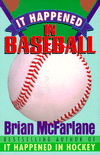

 |

|

The average rating for It Happened in Baseball: Amazing Tales from the Fields of Dreams based on 2 reviews is 3 stars.
Review # 1 was written on 2016-08-01 00:00:00 Richie Conley Richie Conley[the beautiful mansion Belle Monde is originally explained as having been built by an ancestor on the heroine's father's side for his wife, many years ago (before the Civil War). But then throughout the rest of the book, the running theme is that the same home was on the heroine's mother's side of the family, and her mother and aunt grew up there together. The home didn't make it to heroine's father's side until the marriage of her mother and aunt to two brothers from the same family. (hide spoiler)] |
Review # 2 was written on 2020-10-02 00:00:00 stephen whiteside stephen whitesideOne of the most common critiques you hear against using dreams in literature is, "why would I want to read someone else's dreams?" with, perhaps, the unspoken admission that one's own dreams are that banal. Many of the literary dream journals published in the last century seem to prove this concern, whether more academic presentations like Helene Cixous's "Dream I Tell You" or Wendy C. Ortiz's "Bruja" (which being named after the Spanish word for witch you might think would contain something of the magical), to the more frenetic yet still quotidian dreams of Keroac's "The Dream Book." Even the dream diaries of noted Surrealists—Michel Leiris's "Nights as Day, Days as Night," and Georges Perec's "La Boutique Obscure"—read as transpositions of the everyday rather than as windows into the numinous strangeness of the unconscious. Not so with Anna Bonus Kingsford's "Dreams and Dream-Stories." Kingsford's dreams feature apocalypses, adventures, meetings with the gods, and other wonders one might find in exciting genre tales from today, which is remarkable given that it was published in 1888. Perhaps this is a question of selection—Kingsford chose to include dreams that were not her common dreams, what Carl Jung called "big dreams." One wonders what leads some to have these kind of oneiric visions, especially ones that bespeak of collective archetypes. Kingsford was in her daily life a part of larger than life activities—she was the first female physician, a feminist and animal rights activist. She was also a practicing Theosophist who regularly had trance-induced mystical visions. So perhaps these dreams are a reflection of her everyday life, but a life not spent enmeshed in the banal. Another thing that makes these dreams more interesting to read is their literariness. Kingsford seems to have approached recording her dreams as if they were already stories. There is a focus on scene-setting, description, dialogue, conflict as opposed to a hasty scrawl of raw impressions. Granted some of the dialogue tends toward lengthy metaphysical monologues I have a hard time believing were true transcripts of her night-time interlocutors. But still, this is definitely worth a read for anyone interested in using dreams in a literary form in a manner that is actually worth reading. |
CAN'T FIND WHAT YOU'RE LOOKING FOR? CLICK HERE!!!